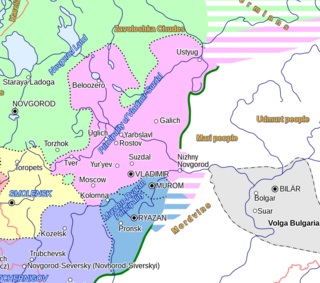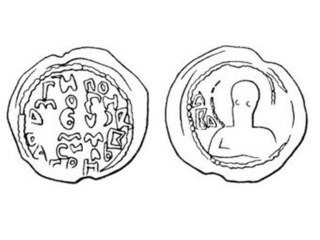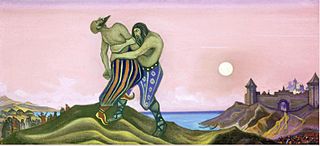
Vsevolod I Yaroslavich was Grand Prince of Kiev from 1078 until his death.

Vladimir I Sviatoslavich or Volodymyr I Sviatoslavych, given the epithet "the Great", was Prince of Novgorod from 970 and Grand Prince of Kiev from 978 until his death in 1015. The Eastern Orthodox Church canonised him as Saint Vladimir.

Yaroslav I Vladimirovich, better known as Yaroslav the Wise, was Grand Prince of Kiev from 1019 until his death in 1054. He was also earlier Prince of Novgorod from 1010 to 1034 and Prince of Rostov from 987 to 1010, uniting the principalities for a time. Yaroslav's baptismal name was George after Saint George.
The Grand Prince of Kiev was the title of the monarch of Kievan Rus', residing in Kiev from the 10th to 13th centuries. In the 13th century, Kiev became an appanage principality first of the grand prince of Vladimir and the Mongol Golden Horde governors, and later was taken over by the Grand Duchy of Lithuania.

Vladimir-Suzdal, formally known as the Principality of Vladimir-Suzdal or Grand Principality of Vladimir (1157–1331), also as Vladimir-Suzdalian Rus', was one of the major principalities that succeeded Kievan Rus' in the late 12th century, centered in Vladimir-on-Klyazma. With time the principality grew into a grand principality divided into several smaller principalities. After being conquered by the Mongol Empire, the principality became a self-governed state headed by its own nobility. A governorship of principality, however, was prescribed by a jarlig issued from the Golden Horde to a Rurikid sovereign.

Vladimir II Monomakh was Grand Prince of Kiev from 1113 to 1125. He is considered a saint in the Eastern Orthodox Church and is celebrated on May 6.

Rogneda Rogvolodovna, also known as Gorislava or Ragnhild (Ragnheiðr), was a princess of Polotsk and one of the wives of Vladimir the Great. She was the daughter of Rogvolod (Ragnvald), who came from Scandinavia and established himself at Polotsk in the mid-10th century.
Sviatoslav II Iaroslavich or Sviatoslav II Yaroslavich was Grand Prince of Kiev between 1073 and 1076. He was born as a younger son of Grand Prince Yaroslav the Wise, and became the progenitor of the Sviatoslavichi (Svyatoslavychi). His baptismal name was Nicholas.
Grand prince or great prince is a title of nobility ranked in honour below Emperor, equal to Archduke, King, Grand duke and Prince-Archbishop; above a Sovereign Prince and Duke.
Gytha of Wessex was one of several daughters of Harold Godwinson, the last Anglo-Saxon king of England, and his consort, Edith the Fair. Through marriage to Vladimir II Monomakh, Gytha became a princess of Kievan Rus'.
Oleg Svyatoslavich ; c. 1052 – 1 August 1115) was a Rus Sviatoslavichi prince whose equivocal adventures ignited political unrest in Kievan Rus' at the turn of the 11th and 12th centuries. He reigned as Prince of Chernigov from 1097 to 1115, and was the progenitor of the Olgovichi family.

The Principality of Chernigov was one of the largest and most powerful states within Kievan Rus'. For a time the principality was the second most powerful after Kiev. The principality was formed in the 10th century and maintained some of its distinctiveness until the 16th century. The Principality of Chernigov consisted of regions of modern-day Ukraine, Belarus, and Russia.

Mstislav Vladimirovich was the earliest attested prince of Tmutarakan and Chernigov in Kievan Rus'. He was a younger son of Vladimir the Great, Grand Prince of Kiev. His father appointed him to rule Tmutarakan, an important fortress by the Strait of Kerch, in or after 988.
Izgoi is a term that is found in medieval Kievan Rus'. In primary documents, it indicated orphans who were protected by the church. In historiographic writing on the period, the term was meant as a prince in Kievan Rus' who was excluded from succession to the Kievan throne because his father had not held the throne before, as exemplified by Yaroslav the Wise's two youngest sons becoming izgoi.

Kievan Rus', also known as Kyivan Rus' was a state and later an amalgam of principalities in Eastern and Northern Europe from the late 9th to the mid-13th century. The name was coined by Russian historians in the 19th century. Encompassing a variety of polities and peoples, including East Slavic, Norse, and Finnic, it was ruled by the Rurik dynasty, founded by the Varangian prince Rurik. The modern nations of Belarus, Russia, and Ukraine all claim Kievan Rus' as their cultural ancestor, with Belarus and Russia deriving their names from it, and the name Kievan Rus' derived from what is now the capital of Ukraine. At its greatest extent in the mid-11th century, Kievan Rus' stretched from the White Sea in the north to the Black Sea in the south and from the headwaters of the Vistula in the west to the Taman Peninsula in the east, uniting the East Slavic tribes.
Iaroslav Sviatopolkovich, also known as Iaroslav or Yaroslav Sviatopolchich, was Prince of Volhynia from 1100 to 1118.
This is a select bibliography of post-World War II English-language books and journal articles about the Early Slavs and Rus' and its borderlands until the Mongol invasions beginning in 1223. Book entries may have references to reviews published in academic journals or major newspapers when these could be considered helpful.








